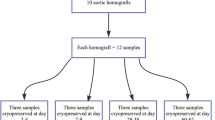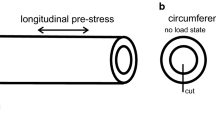Abstract
We evaluated the impact f standard cryopreservation on mechanical and functional properties of human aortic homografts. From 14 human heart-valve donors, the thoracic descending aorta was obtained. Effects of cryopreservation on mechanical (elastic properties and breaking stress) and smooth muscle cell (SMC) and endothelium function were tested. Cryopreservation (cryo) did not significantly affect Young's modulus of elastin (fresh: 3.1 ± 1.0, cryo: 2.7 ± 0.9 × 105 Nm–2), collagen recruitment pressure (fresh: 1.1 ± 0.3, cryo: 1.1 ± 0.4 × 104 Nm–2), distensibility (fresh: 3.8 ± 1.8, cryo: 3.6 ± 1.6 × 105 N–1m2), or breaking stress (fresh: 2.4 ± 1.0, cryo: 2.2 ± 1.0 × 106 Nm–2). Following explantation, no endothelium-dependent relaxation was found. SMC function and endothelium-independent relaxation were mainly intact after explantation but significantly decreased after cryopreservation. Aortic mechanical properties are not influenced by cryopreservation. Following explantation, almost no endothelial cell function is present, and SMC contractility is strongly affected after cryopreservation.
Similar content being viewed by others
Author information
Authors and Affiliations
Additional information
Received: 3 March 2000 Accepted: 27 April 2001
About this article
Cite this article
Langerak, S., Groenink, M., van der Wall, E. et al. Impact of current cryopreservation procedures on mechanical and functional properties of human aortic homografts. Transpl Int 14, 248–255 (2001). https://doi.org/10.1007/s001470100309
Published:
Issue Date:
DOI: https://doi.org/10.1007/s001470100309




